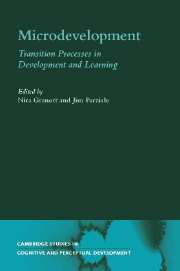Book contents
- Frontmatter
- Contents
- List of figures
- List of tables
- List of contributors
- Microdevelopment: A process-oriented perspective for studying development and learning
- Part I Variability
- 1 Microgenetic studies of self-explanation
- 2 Microdevelopment and dynamic systems: Applications to infant motor development
- 3 Looking at the hands through time: A microgenetic perspective on learning and instruction
- Part II Transition mechanisms
- Part III Micro- and macrodevelopment
- Part IV Context
- Author index
- Subject index
- References
3 - Looking at the hands through time: A microgenetic perspective on learning and instruction
Published online by Cambridge University Press: 22 September 2009
- Frontmatter
- Contents
- List of figures
- List of tables
- List of contributors
- Microdevelopment: A process-oriented perspective for studying development and learning
- Part I Variability
- 1 Microgenetic studies of self-explanation
- 2 Microdevelopment and dynamic systems: Applications to infant motor development
- 3 Looking at the hands through time: A microgenetic perspective on learning and instruction
- Part II Transition mechanisms
- Part III Micro- and macrodevelopment
- Part IV Context
- Author index
- Subject index
- References
Summary
Methods for studying learning typically involve three steps: Assess the learner's knowledge of the task. Provide instruction or some form of intervention on the task. Reassess the learner's knowledge of the task. Any improvement that the learner demonstrates between assessment 1 and assessment 2 is assumed to constitute learning. This method can provide rich information about the effect of intervention on a learner's initial state – it elegantly documents that learning has occurred. However, the method tells us very little about how the learner arrives at the final state – it tells us little about the process of learning.
Microgenetic methods (Siegler & Crowley, 1991) were developed to investigate the small steps learners take in their acquisition of knowledge, particularly steps taken just prior to apparent progress (Karmiloff-Smith, 1992; Kuhn, Garcia-Mila, Zohar, & Andersen, 1995; Siegler & Jenkins, 1989). The goal of microgenetic studies is to examine the learner, not just before and after instruction as in traditional training studies, but throughout the learning process. Such studies provide a spotlight on the period of transition itself.
The spotlight can, of course, have a wide or narrow beam. We can examine change over a period of minutes, hours, days, weeks, or years. One challenge in microgenetic studies is selecting the appropriate time period over which to view change. The appropriate units and intervals between them depend on the pace at which we expect change to occur.
- Type
- Chapter
- Information
- MicrodevelopmentTransition Processes in Development and Learning, pp. 80 - 106Publisher: Cambridge University PressPrint publication year: 2002
References
- 15
- Cited by



